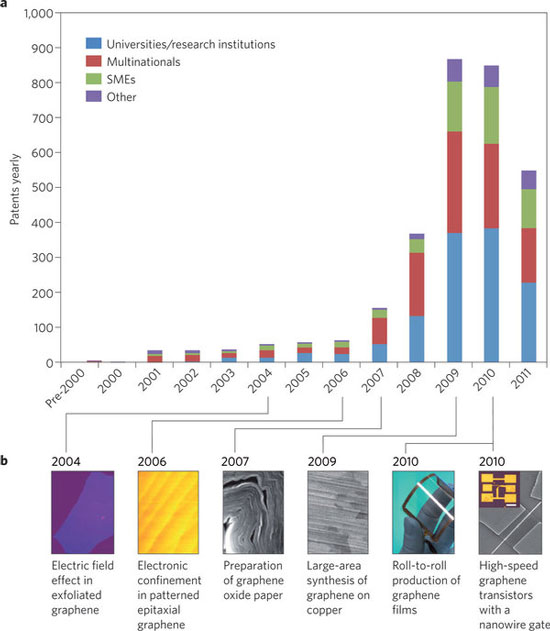| Dec 16, 2011 |
Concerns over how 'UK plc' will realise returns on investments into graphene research
|
|
(Nanowerk News) As the UK government invests into supporting graphene research, the patent activity of UK universities lags behind that of their global peers according to research by CambridgeIP published in Nature Materials ("Exploiting carbon flatland").
|
|
"Since 2007 there has been a rapid increase in the rate of global patent filings around graphene. And patents are central to business models and business strategies in many key application sectors for graphene developments, such as semiconductors and biotech." said Quentin Tannock (Chairman, CambridgeIP) "Despite playing host to Nobel Prize-winning graphene researchers, UK academic institutions hold far fewer graphene patents than their peers in China, South Korea and the USA. This raises the serious question of how 'UK plc' will reap commercial
returns on its significant cash investments into academic research into graphene."
|
 |
| a, The number of patent applications by year. Patent applications may be unpublished for 18 months or more. Therefore the number of patents for the past two years may be underrepresented. b, Timeline of some representative scientific discoveries. (© Nature Publishing Group)
|
|
As the first 2D crystal discovered and with unusual electronic, optical and mechanical properties, graphene is of interest across industry fields as diverse as Aerospace, Biotech, Energy, Industrial Chemicals and Semiconductors. The UK's Chancellor of the Exchequer, George Osborne, has recently announced a £50 million grant to support UK-based graphene research and "fund a national research programme that will take this Nobel Prize-winning discovery from the British laboratory to the British factory floor"
|
|
CambridgeIP has analysed the patent landscape around graphene with a particular focus on the impact of universities and academic institutions. Our graphene patent landscape, reviewed in an article in Nature Materials, indicates that university collaborations with industry and industrial sponsorship of university research are common in the graphene space. Many universities around the world have been successful in developing graphene technologies and then licensing out patents covering these technologies to industrial players.
|
|
"One of the striking features of the graphene patent landscape is what is not present. Andre Geim, one of the two winners of the 2010 Nobel Prize in Physics "for groundbreaking experiments regarding the two-dimensional material graphene" is not listed as an inventor on any published graphene patent application. The University of Manchester has applied for significantly fewer patents than its global peers in graphene research."
|

